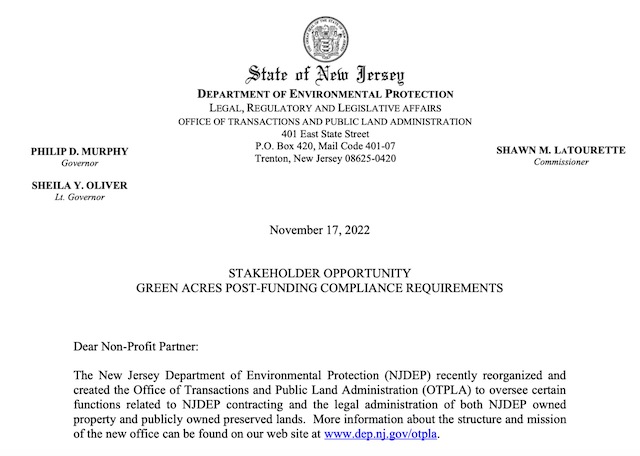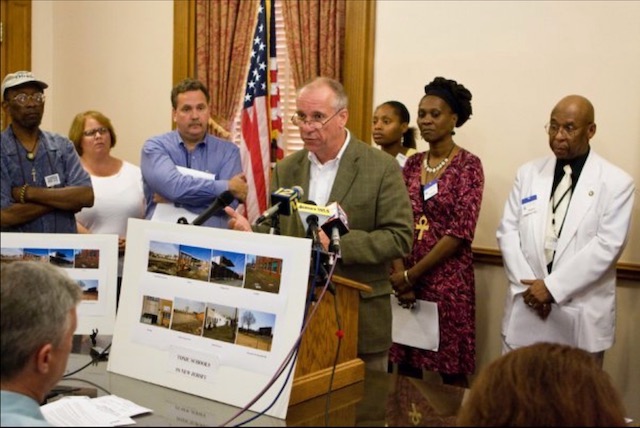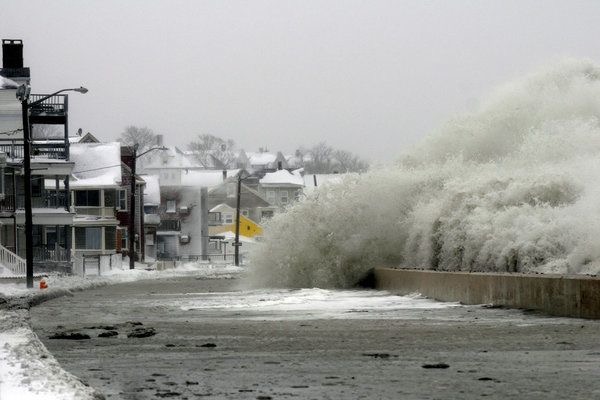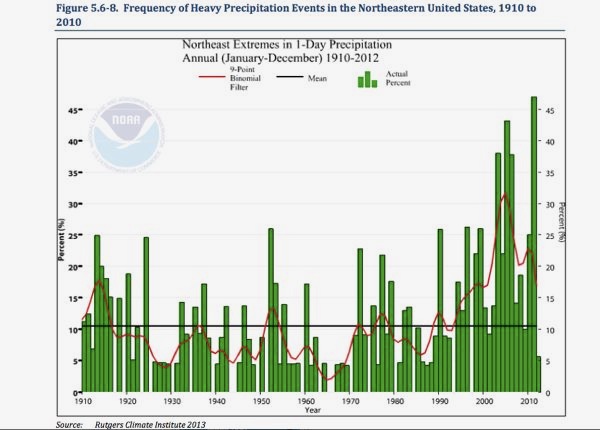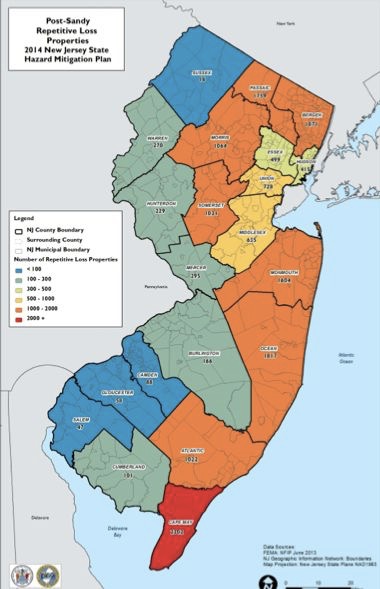Cornell University National Study Examines NJ’s “Blue Acres” Voluntary Flood Buyout Program
Managed Retreat Must Be The Priority Policy and Planning Focus
“Equity” is Not An Adequate Land Use Planning Policy
I was just Googling around to check out what was happening at Cornell’s Department of City and Regional Planning (where I studied for the Master’s degree in 1983-85), and came across the following recent interesting Cornell study:
New Jersey’s “Blue Acres” program was one of 5 programs analyzed in the national study.
Climate-exacerbated flooding has renewed interest in home buyouts as a pillar of flood risk reduction and managed retreat from coastal zones and floodplains in the United States. However, floodplain buyout programs, especially the country’s largest one funded by the Federal Emergency Management Agency (FEMA), have drawn widespread criticism for being overly bureaucratic and socio-economically and racially inequitable (Hino et al. 2017; Howell and Elliott 2018; Mach et al. 2019; Peterson et al. 2020; Elliott et al. 2021). A growing body of research examines how to reform federal policies, what policies to replace them with, and what barriers stymie policy implementation (Kraan et al. 2021; Mach and Siders 2021; Hino and Nance 2021). More research on past and existing buyout programs is needed to support policy learning and coordination (Greer and Brokopp Binder 2017).
In this paper, we examine five dedicated subnational (state, county, and local) buyout programs in New Jersey, Washington State, Charlotte-Mecklenburg County (North Carolina), Harris County (Texas), and Austin (Texas) to understand whether regional buyout programs offer alternative approaches that can inform either future federal policy reform or an expansion of subnational buyout and floodplain management programs.
Right off the bat, the narrow focus on equity and criticism of bureaucracy set off alarms bells.
But the Cornell authors did recognize the need for and benefits of buyouts as a part of “managed retreat”:
Conceptually, buyouts are a triple win: vulnerable residents move out of harm’s way, the government reduces its liabilities, and land can be restored and increase the area’s resilience to future floods. Done well, buyout parcels can generate additional social and ecological benefits, from reducing urban heat islands to creating habitat corridors and public green space.
But, as I’ve written many times, voluntary buyouts are just one small part of a “managed retreat” policy, planning, and management framework. And “equity” is just one dimension of a buyout program.
Clearly, NJ’s scattershot reliance on willing sellers can not address the massive magnitude of a managed retreat program.
In addition to voluntary buyouts, a real “managed retreat” program would require regional planning, including restrictions on rebuilding storm damaged properties, revocation of NJ’s “right to rebuild” storm damaged properties, condemnation of property, regulatory mandates, and resettlement land use planning and financial assistance for displaced residents as we retreat from flood prone coastal and inland river locations.
I had hoped the Cornell study would address these larger issues. And push the envelope into more progressive solutions, honoring the intellectually bold planning approach that I learned there 40 years ago.
Sadly, I was disappointed by the narrow focus on traditional voluntary buyout programs:
In this paper, we focus on FEMA’s Hazard Mitigation Grant Program (HMGP), which accounts for 70% of federally funded buyouts and has bought out over 43,000 properties since its inception in 1989 (Mach et al. 2019).Footnote 1 FEMA funding is awarded to state or local governments, who must provide a 25% match, following a presidential disaster declaration (FEMA 2016). The program’s chief goal is to reduce the National Flood Insurance Program’s liabilities for helping insured homes rebuild after repetitive floods.
I was also embarrassed by the “analysis” New Jersey’s “Blue Acres” program, which is not only misleading but riddled with fact errors. Here’s how it was described: (emphasis mine)
New Jersey Blue Acres
New Jersey, the densest state in the country, is also one of the most flood-prone, with heavily developed floodplains near New York City and development along the sandy coastal plain (CDC 2011; U.S. Census Bureau 2021). The combination of increased rainfall and development in the region have contributed to eight federal flood-related disasters in New Jersey since 1962 (FEMA n.d.). Hurricanes and tropical storms are expected to reach New Jersey’s latitude more regularly under climate change, causing heavier rainfall, storm surge, and riverine floods (NJ DEP 2020). In 1961, the state Department of Environmental Protection founded the Green Acres program to acquire and preserve undeveloped land to create a statewide open space network. In 1995, it established Blue Acres as an extension and partner of Green Acres to address flood prone properties. Blue Acres acquires contiguous parcels to maximize ecological benefits and uses voluntary buyouts to return properties to nature and restore them to passive recreational green space.
Established through three bond acts totaling $36 million, Blue Acres was initially entirely state-funded before securing $273 million from FEMA and HUD after Hurricane Sandy in 2012. As of 2020, 6% of New Jersey’s corporate business tax supports the program,which has enabled Blue Acres to do buyouts on a more strategic, longer-term basis (Spidalieri et al. 2020). These funds enable the program to hire a diversified staff of legal, real estate, financial, and policy experts who help homeowners overcome hurdles and relocate faster than through the federal process (Weber and Moore 2019). Blue Acres’ director, Fawn McGee, has led the program since 1995, developing over time a team of “dedicated and passionate staff” who are in “constant communication” with FEMA and New Jersey Office of Emergency Management (FEMA 2021a, b). In total, Blue Acres has secured funding for 1200 properties and demolished 700 properties (ULI 2020), mostly in inland municipalities. It has not adopted explicit social equity goals or social vulnerability metrics.
The people of NJ impacted by Sandy, flooding, and DEP and FEMA might have a very different and critical assessment and description of what went down. Did the authors interview the real people they purport to be concerned about being dealt with equitably?
But this description is not just misleading, incomplete, and factually false. It is a shockingly poor example of academic rigor.
First of all, NJ DEP’s Blue Acres program is not “strategic”. That’s the term DEP uses on the Blue Acres website. It is not reality. There is no strategy and no enforceable land use plan. The DEP Blue Acres program is opportunistic and relies on scattershot individual willing sellers.
[Update: A reader I trust just sent me an email to advise:
Its worse than you think – it was changed under Christie from Neighborhoods – to property by property – so they do not negotiate by blocks even but each house – it takes 4 times longer that way – also as the state buys out one property- the property next door can get rebuilt. ~~~ end]
The DEP Blue Acres does not “acquires contiguous parcels to maximize ecological benefits”. That’s a slogan, not an achievement in the field.
The “Corporate Business Tax” (CBT) does not provide 6% to Blue Acres, as the study claims:
As of 2020, 6% of New Jersey’s corporate business tax supports the program
The CBT provides 6% to a wide array of DEP and land acquisition programs – just a tiny fraction of the 6% of CBT revenues goes to Blue Acres. It is shocking that an academic paper would not know this. [A reliable reader writes: “Blue acres gets 10% of open space funding or about 7% of CBT funds.”]
In addition to misrepresenting NJ’s Blue Acres program, the study ignored NJ’s statutory “right to rebuild” under the Coastal Area Facilities Act (CAFRA) and Flood Hazard Management Act. That “right’ is a major driver of NJ’s national leading repetitive loss claims.
There is NO MENTION of NJ DEP’s land use planning and regulatory programs, including CAFRA, flood hazard, and stormwater regulations, or the NJ State Development and Redevelopment Plan. And this omission is from an ACADEMIC REGIONAL PLANNING PROGRAM!
The Cornell folks also completely ignored NJ Gov. Christie Christie’s actual post Sandy Rebuild Madness policy, which resulted in BILLIONS of dollars of FEMA and HUD financial aid after Hurricane Sandy driving reconstruction, not buyouts.
And then, after these huge and misleading errors and omissions, the Cornell study goes on to focus primarily on equity and inclusion issues.
I strongly urge readers to read the whole Cornell paper.
But, I also must mention here that the Cornell study not only misrepresented NJ’s Blue Acres and non-existent “managed retreat” programs, it legitimized false premises about “bureaucracy” :
Path forward
President Biden’s Administration has increased disaster funding, reduced their bureaucracy, and prioritized support for disadvantaged groups. Support includes $5 billion for FEMA, doubling the Building Resilient Infrastructure Communities (BRIC) program, requiring 40% of investments to benefit disadvantaged communities, and increasing federal cost share to 90–100% for buildings in socially vulnerable communities under the new Swift Current program (White House 2021; FEMA 2022b). These address many distributive and procedural justice concerns in the literature. However, they do not resolve constraints inhibiting subnational buyout programs from achieving greater equity outcomes, nor do they extend what made subnational programs effective to other geographies. Below, we identify additional ways for federal programs to make buyouts more equitable.
“Bureaucracy” is a very small part of the problem, but a convenient whipping boy and right wing anti-government slogan. It is remarkable that research from an academic planning program echoes that garbage.
Equity is not a land use planning or a policy that can deliver actual “managed retreat”.
Here are some of the headers of the study’s recommendations, which while legitimate, none of which grapple with the primary “managed retreat” policy and planning problems:
- Increase federal funding for institution building at state and county levels
- Create multi-sectoral programs at federal, state, and local levels to enable more integrated problem solving
- Allow local governments to spend federal funds more flexibly, including for pre-disaster mitigation
- Grow a professional cadre trained in inclusive and anti-racist planning and practice
This study is an embarrassment and a far cry from real regional land use planning we will need to adapt to the climate emergency.
I’m really disappointed by the folks at Cornell allowing this to pass for scholarship.


